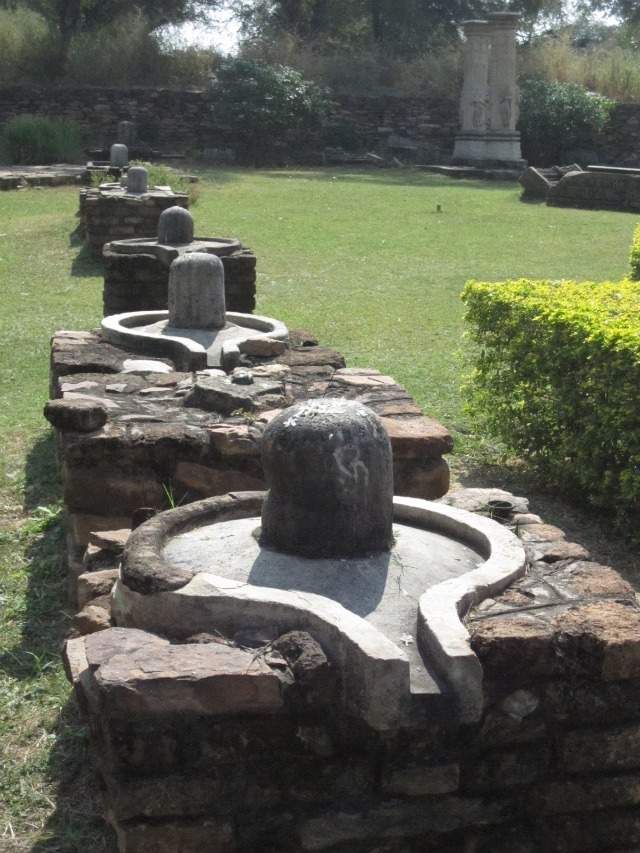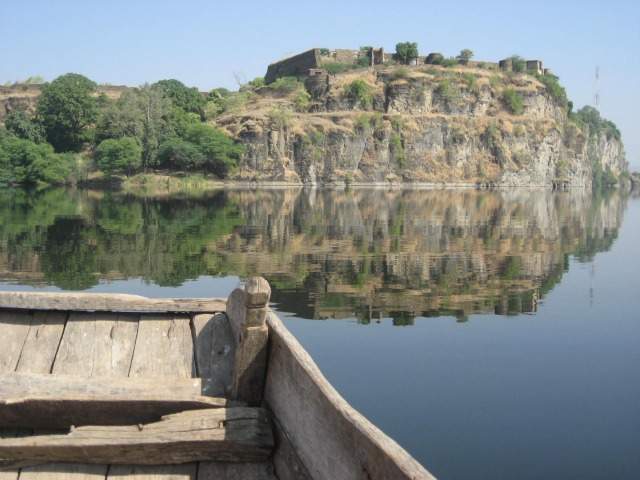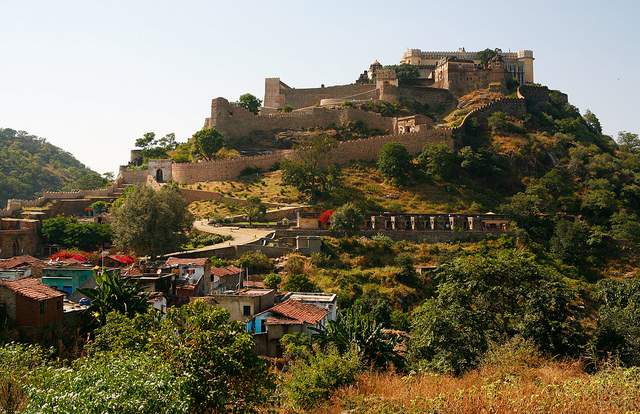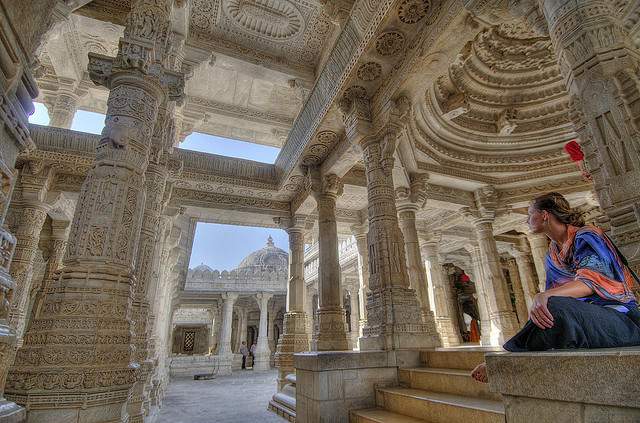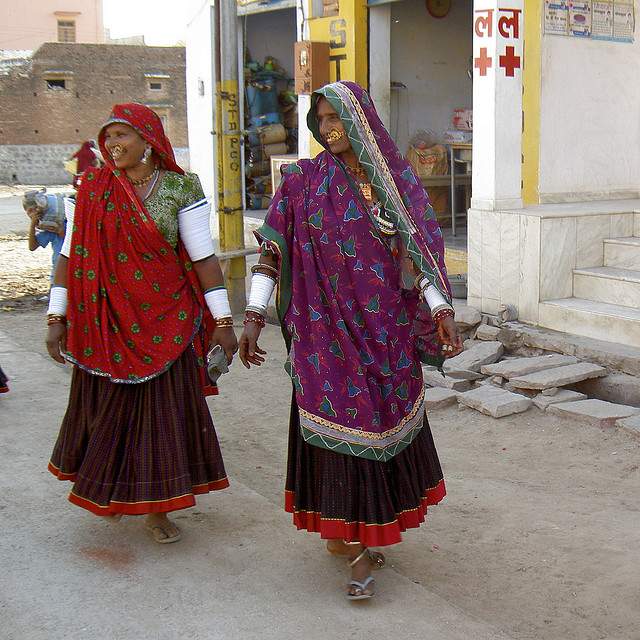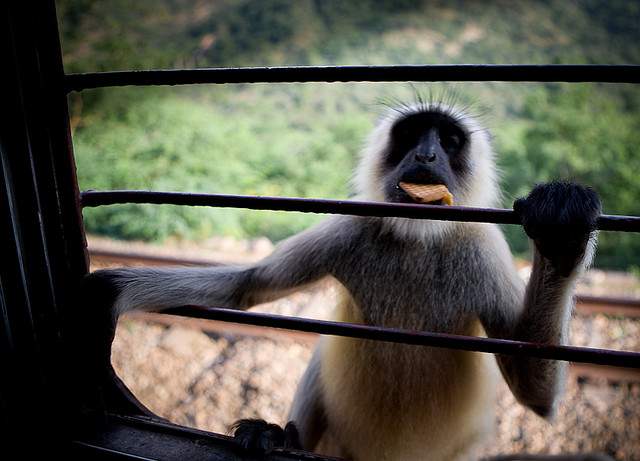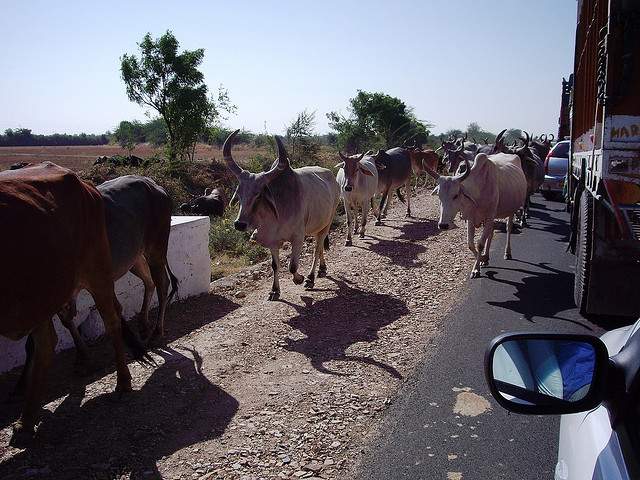By Anne Supsic
Published on BootsnAll.com on February 2, 2012
Explore the world of the Rajputs and witness a way of village life that hasn’t changed much in hundreds of years. From step wells to sexy sculptures, Anne Supsic shows you how to dig deeper into Rajasthan...
Most travelers to India concentrate on the “Golden Triangle,” a hugely popular route covering the cities of Delhi, Agra (for the Taj Mahal), and Jaipur. All three are well worth visiting, but these megacities can be overwhelming and often leave you gasping for fresh air while yearning for a bit of peace and quiet. To get away from the masses and experience India on a more personal scale, you need to dig a little deeper.
Published on BootsnAll.com on February 2, 2012
Explore the world of the Rajputs and witness a way of village life that hasn’t changed much in hundreds of years. From step wells to sexy sculptures, Anne Supsic shows you how to dig deeper into Rajasthan...
Most travelers to India concentrate on the “Golden Triangle,” a hugely popular route covering the cities of Delhi, Agra (for the Taj Mahal), and Jaipur. All three are well worth visiting, but these megacities can be overwhelming and often leave you gasping for fresh air while yearning for a bit of peace and quiet. To get away from the masses and experience India on a more personal scale, you need to dig a little deeper.
Rajasthan was once called
Rajputana, “the land of the Rajputs.” Out in the countryside, you can follow the
history of these fiercely independent warriors who never gave up their struggle
against the Mughal rulers. In fact, many historians believe the Rajputs were
responsible for keeping Hinduism alive during the 300+ years of Muslim rule. In
addition to exploring the vestiges of Rajput power, you can visit small villages
and witness a way of life that hasn’t changed much in hundreds of years.
Create your own triangle anchored by Jaipur, Udaipur, and Jodhpur – and enter a time warp as you focus on the lesser known sights of Rajasthan along the way. Here are 8 of those lesser knowns:
1. Bundi — Miniature paintings and massive step wells
Perfectly located between Jaipur and Udaipur, Bundi is an unspoiled gem with a manmade lake and a fairytale Maharajah palace cascading down the mountainside. This sweet small city was the capital of a major princely state during the glory days of the Rajputs, and the proud people of Bundi remained independent even under British rule, only becoming part of India after Independence in 1947. Bundi is tourist friendly and hassle-free. As a sign on one of the hotels in the old quarter says, this is a town where “Tourist is God.”
Bundi is famous for miniature paintings, and the enchantingly decayed Bundi Palace boasts a remarkably well-preserved collection. The palace building is an excellent example of Rajput architecture with a magnificent Elephant Gate entranceway built in 1607. Take a look at the open courtyard below the gate where mahouts used to get their elephants liquored up for staged elephant fights, a favorite entertainment of the Maharajah who watched from his elegant balcony above.
Inside, you can view stunning paintings still glowing with lustrous color, particularly the brilliant blues made from the gemstone lapis lazuli. In the “Krishna room,” the playboy god appears in twelve paintings (one for each month), including the scene of a playful Krishna stealing the garments of bathing maidens and hanging their clothing out of reach in a nearby tree. Artists still live and work in Bundi – you can even have a miniature peacock or elephant painted on your fingernail!
Bundi is called the Step Well City with more than 50 step wells, called baori, still in existence. Step wells date back to 550 A.D. and were designed as huge water tanks that could be accessed at any water level via multiple flights of stairs. The deep basins filled with water during the torrential rains of the monsoon season and served as reservoirs during the hot, dry summers. But these magnificent structures were more than just wells; they were also places for prayer or meditation and a refreshing spot for cooking and bathing.
The elaborate stepwell of Rani Ji-Ki-Baori was built by a queen in 1699 with 200 steps descending 150 ft. The superb carving makes this step well look more like a cathedral than a watering hole. And the zigzagging steps of the step well Dabhai Ka Kund form a geometric design similar to an inverted Egyptian pyramid.
2. Baroli temples – Hidden ancient wonders
Just south of Bundi, the 9thc. Baroli Temples comprise one of the oldest and most striking temple complexes in Rajasthan. Surprisingly few visitors come here, and as a result, these small temples devoted to Shiva retain a strong sense of the sacred.
The famous British historian Col. James Tod visited Baroli in the 1820’s and wrote of the”unrivalled taste and beauty of Baroli’s sculptures and architecture.” The Colonel knew what he was talking about. The temples reveal marvelous stone sculpture including a porch ceiling where every inch is covered in fantastic carvings. A highlight of the main shrine is a bas-relief dedicated to the “big three” of the Hindu religion (easy to remember using the handy acronym GOD): Brahma the Generator (god of creation); Vishnu the Operator (preserver of the universe), and Shiva the Destroyer. Lord Shiva is not as violent as the name may suggest; the Destroyer brings about change and is also the god of fertility.
The most obvious symbols of Shiva’s fertility power are the lingams, sculptures of the male and female sex organs that dot the temple grounds, honoring Shiva in an orgy of sexual union. Eroticism, which is a common element of the Hindu religion, was actually a reaction to newer religions like Buddhism that advocated avoiding the temptations of the flesh to pursue spirituality. The Hindus, who hated the idea of giving up physical pleasures, responded with erotic temple sculptures and the famous Kama Sutra – all done as a way to glorify sex as a delightful religious experience.
Before you leave, pay your respects to Shiva at the lingam altar and the priest may give you a dot of yellow turmeric paste placed between your eyebrows. These dots or bindis represent the third eye (the gateway to higher consciousness), and the color yellow promotes inner wisdom.
3. Bhainsrorgarh – A fort on a river of glass
A short ride west of Baroli, Bhainsrorgarh Fort offers one of Rajasthan’s most atmospheric accommodations in an authentic fortified outpost perched at the end of a promontory standing 200 ft. above the crocodile-infested Chambal River. Our old friend Col. Tod wrote that if he had been offered a fiefdom anywhere in Rajasthan, he would have chosen Bhainsrorgarh.
Today, Bhainsrorgarh Fort is a family home turned into a small hotel. Throughout India, many former royal families have transformed their homes into hotels, but what makes Bhainsrorgarh special is that the family still operates the hotel themselves. And they have purposely avoided too many alterations so that you can live the life of the rural gentry, even if it’s only for one night.
A short, steep hike leads to the river’s edge where local boatmen offer rides in rickety wooden boats. The river is nearly 500 yards wide and 40 ft deep with a surface so placid that it is like a mirror. The river so perfectly reflects the magnificent fort above that it feels as if you are floating into an Impressionist painting.
Be sure to walk around the small village with its rainbow-colored houses and curious residents. Tourists are still a novelty here, and a stroll through the village will make you feel like the Pied Piper of Bhainsrorgarh as giggling village children trail along in your wake. I bought some toothpaste at a small shop, and when I turned to leave, I saw that I had attracted a crowd of about 30 people who had gathered around to see what I was doing.
4. Kumbhalgarh – Rajasthan’s most impregnable fort
Just over 50 miles north of Udaipur, Kumbhalgarh Fort is considered the most impregnable in Rajasthan with 25 miles of walls, reputedly the second longest continuous wall in the world (after the Great Wall of China). Kumbhalgarh was a bastion of Rajput power; it was only taken once and that required a combined force of the Mughals and their allies. The fort may also have the best location in Rajasthan: the isolated spot is surrounded by nothing other than the rounded mountains of the ancient Aravalli Hills, considered by some to be the oldest mountains in the world.
Kumbhalgarh is a huge complex with 360 temples, 700 canon bunkers, a palace, and a village where people go about their normal business in spite of living in a tourist site. The mighty walls feature seven gates and distinctive, bulbous towers.
Great forts require great sacrifices, and when building began in 1443, King Rana Kumbha had more than the usual new construction frustrations. According to a popular legend, any work completed on the fort during the day would crumble to ruins by sunset. A spiritual advisor explained that the fort would never be built without a human sacrifice. And here’s the kicker: the sacrifice had to be voluntary. Not one of the king’s subjects volunteered to be beheaded, but eventually a pilgrim wandered by and offered himself up. The fort was completed, and the main gate, Hanuman Pol, contains a shrine commemorating the sacrifice — right at the very spot where the pilgrim’s head fell.
5. Ranakpur Temple – Home of the Jains
The nearby Ranakpur Temple is one of the most beautiful Jain temples in all of India. The Jains are an unusual religious group, unique to India, founded 2600 years ago. Jainism was one of those “new” religions that frustrated the Hindus by shunning the material world. The Jains are vigilant vegetarians renowned for their extreme respect for all forms of life. The most devout Jain monks even gave up clothing and walked around naked except for masks over their mouths to prevent accidentally inhaling an insect.
Ranakpur Temple is a white marble wonder supported by a forest of 1,444 pillars all carved with exquisite designs. The unusual temple layout also includes five spires and a maze of 29 halls topped by 80 domes. The temple is said to be built in the form of a celestial vehicle, and Ranakpur is, without a doubt, heavenly. The stunning ceiling designs include an “om” symbol combined with a half moon, and a stylized figure with one head and five bodies that represents the need to control the five senses when entering the temple. Note that in deference to the Jain disdain for harming any creatures, no leather items are permitted in the temple.
6. Narlai – A walk in the village
Situated between Udaipur and Jodhpur, the little village of Narlai is a convenient base for visiting both Kumbhalgarh and Ranakpur. If you can afford one hotel splurge, the heritage property of Rawla Narlai should be it. Seated at the foot of a massive 350 ft. high domed rock in the middle of a sweet country village, this luxurious 17th c. hunting lodge, once favored by the Maharajah of Jodhpur, is a little bit of Rajasthani heaven. (Mick Jagger liked the place, and if it’s good enough for Mick…)
The lovely property is decorated in an authentic style with an array of old Maharajah photographs hanging on the walls. Modern comforts include a huge pool ideal for laps, and a lavish dinner served on the roof terrace amid flickering candles and the soothing sounds of the harmonium (similar to an accordion) accompanied by a set of tabla (Indian bongo drums). If you are really feeling flush, you can opt for the step well dinner and dine by an 1100-year old step well, romantically lit with dozens of oil lamps.
A favorite activity is the town walk led by a hotel staff member who offers unique insight into village life. The walk begins with a tour of a Shiva temple carved inside the rocky mountain. A metal statue of a cobra adorns the temple altar, and during festivals, the villagers bring in the real thing. Some brave soul milks the live cobra, and then everybody drinks some cobra milk!
The walk continues with visits inside villagers’ homes such as the home of a shoemaker hard at work finishing colorful wedding shoes for a soon-to-be-married bride and groom. Of course, cows are venerated in India, and one small house had just three rooms with the middle room reserved for the cow! In another house, a woman proudly showed off her nicely swept floor covered with a mixture of dirt and cow dung. (Many Indians believe that cow dung keeps a house cool and antiseptic.)
During my village walk, I even got to join a group of local Hindu women gathered on the stoop of a village home. We had no common language but managed to communicate, mostly by admiring each other’s jewelry. We got along well enough although I was a bit concerned about the way they kept slapping my thigh (hard) and laughing. Made me think they had never come across a leg quite so hefty before!
7. Jojawar – Into the Aravalli Hills
The village of Jojawar, situated just two hours north of Narlai, is home to Rawla Jojawar, a heritage hotel offering a cheaper alternative to Rawla Narlai. The hotel is a converted garrison fort with a reception desk in the former magistrate’s office and small rooms nearby that were once used as jail cells. Speaking of reception, the welcome here is one you will be unlikely to forget: a drummer announces your arrival with an energetic drum roll, and the manager sprinkles flower petals over your head just as if you were Rajput royalty.
Two favorite activities in Jojawar are the jeep safari and the train excursion. The open-top jeep safari offers ample opportunities to see antelopes, camels, peacocks, and lots of monkeys. The trip may also include a visit with the Rabaris, a semi-nomadic people who stay on the move, herding their sheep and goats as they follow the rain in this arid region.
The train ride begins at Kambli Ghat station, the highest train station in the Aravalli Hills, and continues through the scenic Kambli Ghat Pass. This is not a tourist train, and one of the best reasons to take this excursion is to share the ride with the locals. The train passes through several tunnels (that were painstakingly carved by hand), and the children onboard laugh and scream each time the train is plunged into darkness. The train makes several stops for brake checks, and one regularly scheduled stop to feed the langur monkeys. These monkeys know exactly when to show up for the biscuits that all the passengers throw from the train, and the adjacent rails are crowded with hungry primates. All the train windows have bars, and when you see how aggressive the monkeys can be, you understand why.
8. Road trip – Life in the fast lane
One more reason to dive into rural Rajasthan is to experience the crazy joys of riding the roads. Since it is downright hazardous to drive yourself, the best way to travel is by hiring a car and private driver. Although this would sound like an extreme extravagance in most parts of the world, in India this mode of transporting tourists is common, reasonably priced, and safe. Not to mention fun.
Riding the rural roads of India ranks right up there with the Taj as one of the most unforgettable of Indian experiences. The roads are jammed with cows, goats, camels, water buffalo, and even the occasional elephant. Not to mention people on foot, riding bicycles or motorbikes, or traveling in tuk-tuks (3-wheeled auto rickshaws). Tuk-tuks are supposed to have a legal limit of four passengers, but they routinely carry a dozen or more, including the young macho types who ride outside, standing on the bumpers and hanging on by their fingertips.
Full-size buses and delivery trucks add to the mélange. Custom painted with a circus car look, these colorful vehicles sport windshields decorated with tinsel, satiny curtains, and strands of garland — each truck looks like it just ran over a fully decorated Christmas tree. And the mirrors almost always display a string of fuzzy black pompoms, good luck charms to ward off accidents and other catastrophes.
And all of this is just the activity on the road. A typical journey passes through tiny villages and larger towns all teeming with women in sparkling saris shopping at the outdoor markets, and men getting haircuts on stools in dusty parking lots or sipping drinks at neighborhood hangouts. You may even see the local dentist seated on the ground, well-positioned on the main drag with a nice choice of dentures spread out on a blanket. He’ll even pull a tooth for you right there on the spot!
Photos by: Carl Welsby,
TushyD, abmiller99, kian
esquire, NoBigShot, lumiere,
photo 2 courtesy of Frank Supsic, photo 3 by Anne Supsic and may not be used
without permission.

